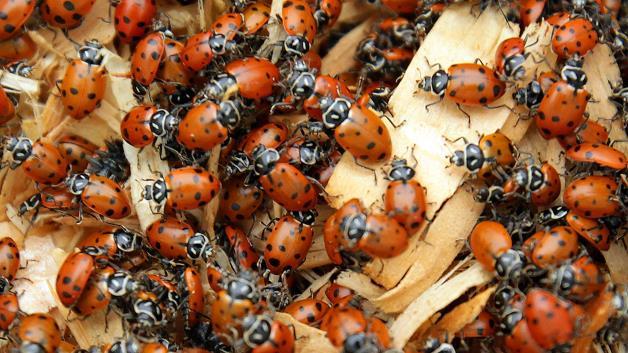November 6, 2013
Millions of ladybugs are invading homes and businesses in parts of the U.S. eastern seaboard and Gulf Coast this fall.

November 6, 2013
Millions of ladybugs are invading homes and businesses in parts of the U.S. eastern seaboard and Gulf Coast this fall.

WINSTON-SALEM, North Carolina — Millions of ladybugs are invading homes and businesses in parts of the U.S. eastern seaboard and Gulf Coast this fall, causing headaches for residents who are fighting the invasion with vacuum cleaners that suck up the insects.
While harmless to humans, masses of the multi-colored invaders are a nuisance as they slip indoors through cracks around doors and windows. Plus they can stain curtains, upholstery and walls if squashed.
A spike in the ladybug population is typical this time of year as they fly out of the farm fields where they help control other insects and seek a warm place to spend the winter.
A mild winter followed by a rainy spring in the east and south created the perfect environment for the species, known as the multicolored Asian lady beetle, to flourish in larger-than-usual numbers in some areas, said David Cook, an entomologist for the University of Tennessee and an extension agent in Nashville.
"It was a perfect insect storm," he said. "They're cute, but no one wants a lot of cute."
The swarms have been particularly bad in the South. In Alabama, Walter Harris said he found a couple hundred of the critters swarming the front door of his house last week, and he knew better than to squash them.
"If you do that, they'll stain real bad," said Harris, coordinator for the county extension office in Huntsville. "The only thing you can do is vacuum them up."
The ladybugs, which have black spots and wing covers that vary in color from red-orange to yellow or tan, gravitate to heated homes and light-colored walls, Cook said.
While they are not harmful, he said people looking to avoid the nuisance should check the weather stripping and insulation of their homes, particularly if they live near wooded areas.
Cook called the beetles a "major problem" in Tennessee, but an insect expert in North Carolina said big swarms of ladybugs in that state were not widespread so far this year.
"We've had a few areas with high populations, but you could go even a mile or two away and not see them," said Michael Waldvogel, an extension entomology specialist at North Carolina State University. "So much depends on surroundings and where the ladybugs were finding prey."
The invasion should be repelled in a few weeks by the onset of cooler weather and a few freezes. Typical patterns in the ladybugs' food supply, mainly aphids, also mean the population will be much smaller next year, Cook said.
"But I'm afraid for a few weeks, it's going to be annoying for some people," he said.
Courtesy: Reuters
















































































































